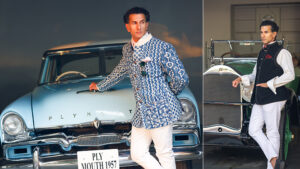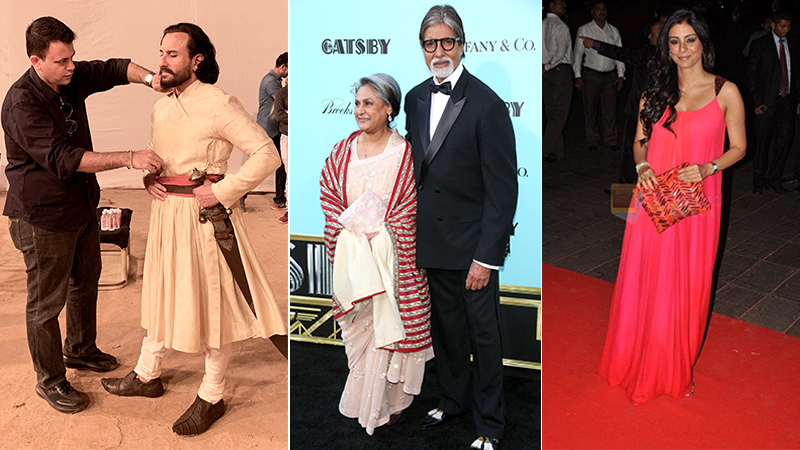I have had many failed attempts to fully understand the role of a stylist since the start of my career. I have worked with leading luxury magazines and I believe style is individualistic and if it remains so, there is likely to be fewer red-carpet disasters.
My question is I know what looks best on me, so why would I have anyone else telling me what to wear and how to wear it? Doesn’t it take away from my identity?
When I began writing on fashion in 1996, and covered fashion shows extensively though the Fashion Design Council of India (FDCI) came into existence in 1998, designers styled their shows themselves.

Arjun Khanna, a veteran of 35 years, has been styling his own shows and sometimes even photographs his collections. Arjun is known for his interesting menswear and is a pioneer in the business. He believes a stylist must share his vision, but now every other person he meets claims to be a stylist.
“They are hired to do many things, almost everything. Celebs hire them to source bags, clothing…guests at the Ambani wedding are being dressed by them, though there are only a handful who possess fine aesthetics,” says Mumbai-based Khanna.
It is a mela out there, he confesses and, frankly, a vicious circle, the demand and easy supply, and the need for instant gratification has caused a frenzy. “Many designers have fallen prey to the charms of a stylist,” he adds.
They now get first class tickets, five-star rooms, and he has also had some bad experiences with clothes being sourced by stylists that are returned with stains or altered without his permission. “I now make them pay a deposit in case my garment is ruined. This bubble will burst…it is only a matter of time,” he admits.

There is considerable money involved too, as stylists charge the celebrity, but the designer whose clothes they source from get nothing in return. Mumbai-based Shahab Durazi, known for his sharp tailoring, admits he has recently explored the path of celebrity dressing. “Most of them are young with fresh ideas and often bring a new perspective to my brand. Although I am selective, I curate looks keeping in mind the celebrity’s personality, body type, and event,” says Shahab.
In many ways he considers himself a stylist more than a designer, so he gets under the skin of the personality he dresses. “I don’t employ a stylist’s services while shooting campaigns or content. My vision for my brand is specific and I want the creative freedom and liberties to explore and attain it unobtrusively. However, for celebrity dressing I have worked with many stylists like Priyanka Kapadia, Ami Patel, Divyak D’souza and Mohit Rai,” he says.
If you study the fashion landscape, 80% of celebrities making public appearances are either from film or television backgrounds. These actors, for the most part, either don’t have an understanding of what is available in the industry and/or lack the time to go looking for appropriate clothing for their public appearances, he adds.
This has given rise to a new breed of young, aspiring individuals who can offer their time and expertise. “Stylists liaison with designers and celebrities and their role determines how clothing and accessories can transform mere products into pieces of art on the human form,” he explains.
Priyadarshini Rao, who has been the architect of engaging pret clothing, admits when she started doing Lakme fashion week, the management gave her a stylist. “I have worked with good ones: Aki Narula and Gautam Kalra,” says Rao. They brought in an objective view, she recounts.
“I don’t like accessories but they gave me ideas on how to use it to uplift a garment,” she says, adding you need an “arrived stylist” as they will edit a collection; designers are sometimes excessive. What has happened in fashion now is that everyone wants to be one, and they choose this over fashion design.”
“My cousin’s daughter was studying in NIFT Kannur. She found pattern-cutting exhausting, so she took styling, which was easier. No one wants to put in hard work,” rues Rao. In 2003, she did Hum Tum’s costumes for Rani Mukherjee and Saif Ali Khan.
She feels it is a lot about massaging egos when you are a stylist; looking out for what the producer, director, and actors demand, and keeping them happy. Rao never did a film again. “Rituparno Ghosh, however, is different, and Karan Johar is different and both approach costumes uniquely,” she adds.
Hollywood needs a stylist, and Broadway needs a designer; there is a marked distinction here. There are lots of women who need to be told what to wear! “The 20-somethings who have money and are devouring these stylists; and if you have a million views to validate what you are saying, on social media, who cares if you have a degree or not?” says Rao, adding, anyone can become a stylist; it is their 15 minutes of fame.
Nachiket Barve, known to dress the Bachchans, believes frontrunners like Rohit Khosla didn’t need stylists; they believed in the idea of the creator’s vision. “Everything was DIY then; it was a smaller industry 40 years ago,” says Barve. A stylist is important as magazines define the season’s narrative, they decode fashion for consumers. “Look, every brand is a publisher, and social media is fuelling this. Jahnavi Kapoor has a cricket movie so the stylist will customise accordingly, like they did for Zendaya in the Challengers,” says Barve. With cameras everywhere amid the social media storm, Barve believes you need to be constantly upping your game if you are a star.

The king of 3D embroideries, Suneet Varma, has been an advocate of the do-it-yourself school, and admits he decides whether to add a sleeve, or lop off a belt. He has been editing his collections and shows for the last 36 years. “I know best; how to style, show and drape it, that’s the USP of my brand – my styling. I am lucky to have been recognised as a stylist,” says Suneet.
Few know that the acclaimed photographer Prabuddhan DasGupta employed the services of Suneet while he was shooting in the 90s — for the Grasim ad, Onida with Amitabh Bachchan, or Garden Saris. “Now the problem is everything is over-styled, as if to show a purpose, and that takes away from the entire look,” he laments.
Styling should be edgy, appealing, surprising, and appeasing, and “you must learn to say no to a stylist like I have,” he confesses. Suneet undertakes four fittings before the final show, so he knows what works.
“I have never used a stylist, and the best stylist according to me is Grace Coddington who, for 40 years, has been looking beyond just clothing,” he says. His experience with young stylists has been challenging: they wouldn’t know “anything about 30s Parisian, or Botticelli’s Birth of Venus… anything about art or costumes,” he says.
“In the Indian context, the definition of a stylist is vague, and just because you can put two things together doesn’t mean you are one. Frankly, most society ladies have stylists now,” he laughs. – Asmita Aggarwal is fashion & lifestyle editor of nrifocus.com


Leave a Reply